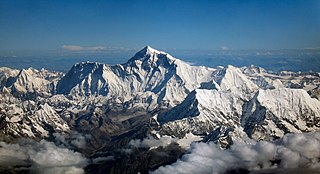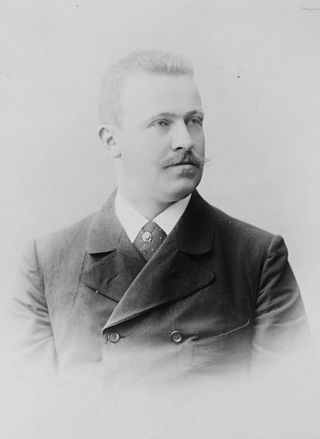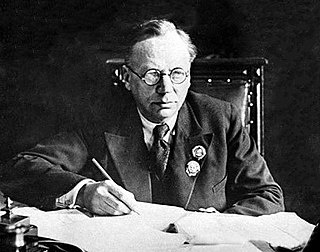
K2, at 8,611 metres (28,251 ft) above sea level, is the second-highest mountain on Earth, after Mount Everest at 8,849 metres (29,032 ft). It lies in the Karakoram range, partially in the Gilgit-Baltistan region of Pakistan-administered Kashmir and partially in the China-administered Trans-Karakoram Tract in the Taxkorgan Tajik Autonomous County of Xinjiang.

The Lewis and Clark Expedition, also known as the Corps of Discovery Expedition, was the United States expedition to cross the newly acquired western portion of the country after the Louisiana Purchase. The Corps of Discovery was a select group of U.S. Army and civilian volunteers under the command of Captain Meriwether Lewis and his close friend Second Lieutenant William Clark. Clark, along with 30 others, set out from Camp Dubois, Illinois, on May 14, 1804, met Lewis and ten other members of the group in St. Charles, Missouri, then went up the Missouri River. The expedition crossed the Continental Divide of the Americas near the Lemhi Pass, eventually coming to the Columbia River, and the Pacific Ocean in 1805. The return voyage began on March 23, 1806, at Fort Clatsop, Oregon, ending six months later on September 23 of that year.

The North Pole, also known as the Geographic North Pole, Terrestrial North Pole or 90th Parallel North, is the point in the Northern Hemisphere where the Earth's axis of rotation meets its surface. It is called the True North Pole to distinguish from the Magnetic North Pole.

Mount Everest is Earth's highest mountain above sea level, located in the Mahalangur Himal sub-range of the Himalayas. The China–Nepal border runs across its summit point. Its elevation of 8,848.86 m was most recently established in 2020 by the Chinese and Nepali authorities.

Erich Dagobert von Drygalski was a German geographer, geophysicist and polar scientist, born in Königsberg, East Prussia.

Koichi Wakata is a Japanese engineer and an astronaut working for Axiom Space. He retired from JAXA in 2024. Wakata is a veteran of four NASA Space Shuttle missions, a Russian Soyuz mission, and a long-duration stay on the International Space Station. During a nearly two-decade career in spaceflight, he has logged more than five hundred days in space. During Expedition 39, he became the first Japanese commander of the International Space Station. Wakata flew on the Soyuz TMA-11M/Expedition 38/Expedition 39 long duration spaceflight from 7 November 2013 to 13 May 2014. During this spaceflight he was accompanied by Kirobo, the first humanoid robot astronaut. As of 2023, he is the longest active astronaut in the world.

Operation HIGHJUMP, officially titled The United States Navy Antarctic Developments Program, 1946–1947,, was a United States Navy (USN) operation to establish the Antarctic research base Little America IV. The operation was organized by Rear Admiral Richard E. Byrd, Jr., USN, Officer in Charge, Task Force 68, and led by Rear Admiral Ethan Erik Larson, USN, Commanding Officer, Task Force 68. Operation HIGHJUMP commenced 26 August 1946 and ended in late February 1947. Task Force 68 included 4,700 men, 70 ships, and 33 aircraft.
The British Graham Land expedition (BGLE) was a geophysical and exploration expedition to Graham Land in Antarctica between 1934 and 1937. Under the leadership of John Rymill, the expedition spent two years in the Antarctic. The expedition determined that Graham Land was a peninsula. The expedition used a combination of traditional and modern practices in Antarctic exploration, using both dog teams and motor sledges as well as a single-engine de Havilland Fox Moth aircraft for exploration. Transportation to the Antarctic was in an elderly three-masted sailing ship christened the Penola, which had an unreliable auxiliary engine. Additional supplies were brought on the ship Discovery II.

The British Australian (and) New Zealand Antarctic Research Expedition (BANZARE) was a research expedition into Antarctica between 1929 and 1931, involving two voyages over consecutive Austral summers. It was a British Commonwealth initiative, driven more by geopolitics than science, and funded by the United Kingdom, Australia and New Zealand.

Eduard Gustav Freiherr von Toll, better known in Russia as Eduard Vasilyevich Toll and often referred to as Baron von Toll, was a Russian geologist and Arctic explorer. He is most notable for leading the Russian polar expedition of 1900–1902 in search of the legendary Sannikov Land, a phantom island purported to lie off Russia's Arctic coast. During the expedition, Toll and a small party of explorers disappeared from Bennett Island, and their fate remains unknown to this day.

Shannon Walker is an American physicist and a NASA astronaut selected in 2004. She launched on her first mission into space on June 25, 2010, onboard Soyuz TMA-19 and spent over 163 days in space.

Vladimir Yulyevich Wiese was a Russian scientist of German descent who devoted his life to the study of the Arctic ice pack. His name is associated with the Scientific Prediction of Ice Conditions theory. Wiese was a member of the Soviet Arctic Institute and an authority on polar oceanography. He was also the founder of the Geographico-hydrological School of Oceanography.

Franklin's lost expedition was a failed British voyage of Arctic exploration led by Captain Sir John Franklin that departed England in 1845 aboard two ships, HMS Erebus and HMS Terror, and was assigned to traverse the last unnavigated sections of the Northwest Passage in the Canadian Arctic and to record magnetic data to help determine whether a better understanding could aid navigation. The expedition met with disaster after both ships and their crews, a total of 129 officers and men, became icebound in Victoria Strait near King William Island in what is today the Canadian territory of Nunavut. After being icebound for more than a year Erebus and Terror were abandoned in April 1848, by which point two dozen men, including Franklin, had died. The survivors, now led by Franklin's second-in-command, Francis Crozier, and Erebus's captain, James Fitzjames, set out for the Canadian mainland and disappeared, presumably having perished.
Avgust Karlovich Tsivolko, also spelled as Tsivolka was a Russian navigator and Arctic explorer.

The area that eventually became the U.S. state of Montana played little direct role in the American Civil War. The closest the Confederate States Army ever came to the area was New Mexico and eastern Kansas, each over a thousand miles away. There was not even an organized territory using "Montana" until the Montana Territory was created on May 26, 1864, three years after the Battle of Fort Sumter. In 1861, the area was divided between the Dakota Territory and the Washington Territory, and in 1863, it was part of the Idaho Territory.

Kimiya Yui is a Japanese astronaut from the Japan Aerospace Exploration Agency (JAXA). He was selected for the agency in 2009.

Anuchin Glacier is a glacier draining southward to Lake Unter-See in the northern part of the Gruber Mountains, Queen Maud Land. It was discovered, and plotted from air photos, by the Third German Antarctic Expedition, 1938–39. It was mapped from air photos and from surveys by the Sixth Norwegian Antarctic Expedition, 1956–60, and remapped by the Soviet Antarctic Expedition, 1960–61, and named after Dmitry Nikolayevich Anuchin, Soviet geographer.

Metridioidea is a superfamily of sea anemones in the order Actiniaria. Members of this clade live in shallow subtropical waters worldwide.

The Ross expedition was a voyage of scientific exploration of the Antarctic in 1839 to 1843, led by James Clark Ross, with two unusually strong warships, HMS Erebus and HMS Terror. It explored what is now called the Ross Sea and discovered the Ross Ice Shelf. On the expedition, Ross discovered the Transantarctic Mountains and the volcanoes Mount Erebus and Mount Terror, named after each ship. The young botanist Joseph Dalton Hooker made his name on the expedition.

















